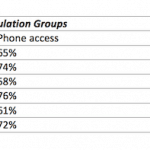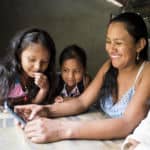Building Markets, Building Cohesion: Lessons from Last-Mile Deliveries
As billions of people still struggle to gain access to stable electricity, many actors in the development sector have recently looked to clean energy technology distribution initiatives to bridge the gap. The model for these last mile distribution programs is generally similar: They are initiated with the support of philanthropic money, with the aim that market forces will eventually bolster a sustainable supply chain. Such technology distribution and adoption initiatives are usually supported by a trusted local network of microentrepreneurs.
Still, the beauty of these technology programs is that they can be framed in many different ways, from supporting microentrepreneurship and market development to women’s empowerment and climate change. Similarly, Kopernik works to find practical and effective solutions that address common challenges faced by communities in remote and rural areas. With our Wonder Women initiative, for instance, Kopernik manages a distribution program that focuses on empowering women microentrepreneurs in distributing technology to communities living in the fringes of eastern Indonesia. Solar Sister, which predominantly operates in Africa, manages a similar model.
Tech for Community and Conflict Resolution
In 2016, the United Nations Development Programme (UNDP) in partnership with Mercy Corps initiated a 16-month pilot program – “Innovative Technologies for Rural Communities” – in Myanmar, utilizing technology distribution as an avenue to strengthen social cohesion. The initiative targeted 100 villages in the states of Kayin, Mon and Shan, working with women and youth as microentrepreneurs in promoting the clean technologies, such as solar lanterns and clean cook stoves. Kopernik provided technical advice at key points of implementation, sharing comparative experience from similar interventions in Indonesia – but also offering an insider-outsider perspective.
At the time, Myanmar was a nation emerging from decades of conflict and isolation. The three target states in particular are home to various ethnic groups struggling with tension, mistrust and competition for natural resources. Social inequalities were also prevalent, with women and youth lacking equal political and economic status. Against such a backdrop, UNDP saw the pilot program as an opportunity to improve social cohesion by increasing the participation of marginalized groups in market and community activities, and to strengthen interaction and dialogue within and between communities. Thus, in this particular case of technology distribution, sales were not the objective; rather, the program strived to prepare communities to better engage in market-based transactions that could support the empowerment of marginalized groups and improve trust in communities emerging from long-lasting conflicts.
This meant that the pilot program had to take into consideration its social impact and additional community outreach in its implementation. For one, the product selection was informed based on the potential benefit to support marginalized groups or to reduce conflicts. As an example, based on a feasibility mission at the start of the program, fuel-efficient cook stoves could help reduce community conflicts around scarce firewood. Another aspect of the program was to combine entrepreneurship training with leadership and peace-building skills training, helping sales agents to envision themselves as decision makers and peace-builders in their communities. The program also mobilized village-level steering committees comprising of community leaders which voluntarily supported and mentored the sales agents.
From Sales to Social Impact
While social cohesion itself is a long-term process, the pilot’s evaluation showed relative success in achieving its social and economic objectives. Approximately 90 percent of sales agents reported improved confidence and leadership skills at the end of the pilot. Sixty-five percent of sales agents reported higher involvement in new village activities, including community development, parent-teacher associations and youth development. On social cohesion, a village leader from Mon state shared that: “Now there is more trust and cooperation among villages. When one village struggles with bookkeeping or other issues, people from other villages come together to share their experiences and help.”
This focus on peace-building and outreach further helped the broader community to perceive more direct benefits and a sense of ownership of the program, which eventually supported sales. For instance, 84.7 percent of the total 6,371 units of products in the supply chain were sold to end-users by August 2016. The program managed to cover nearly 25 percent of the households in some villages, impacting almost one in four households. The two corresponding villages were Hlaingbwe and Hopong with 1,200 and 2,400 households respectively. Based on this pilot, it’s clear these approaches are worth considering when implementing a similar initiative elsewhere.
Further research is needed to determine the sustainability of these social and economic gains. However, the pilot program does demonstrate how entrepreneurship and social leadership go hand in hand to improve social cohesion. This is also seen in Kopernik’s experience with women’s economic empowerment in Indonesia. As sales agents become more empowered economically, they gain the agency and trust to take on more active roles in the community.
For more insights about the pilot program “Innovative Technologies for Rural Communities” in Myanmar, download the full report here.
Tomohiro Hamakawa is chief strategy officer and Vanesha Manuturi is a communications officer at Kopernik.
Photos courtesy of Kopernik.
- Categories
- Energy, Technology



